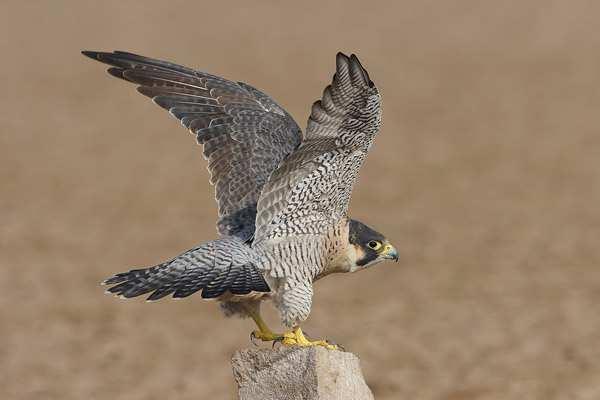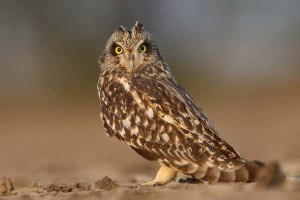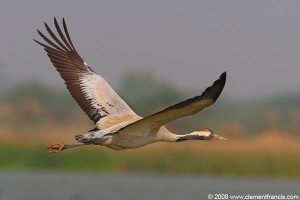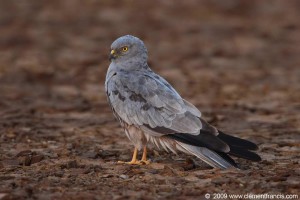
Birds have been a very close to my heart subject for the past 2 decades and among them the raptors or predators hold a very special place. Among these numerous raptors which come in form of Eagles, hawks, kites etc the Peregrine Falcon stands out as the fastest hunter on the face of our planet earth. They have been recorded by scientists/researchers to clock speeds of over 380kms per hour during their dives when chasing their prey (which most times are birds).
It was always my dream to take good photographs of this great bird so that I can share its magnificence with my fellow birders, wildlife photographers and to the general audience who love natural history. Even though I have seen these great predators a couple of times in the Himalayan region, a few times in Greater Rann of Kutch and multiple times in Karnataka and other places, this bird always eluded me for some good photography. Even though a few record shots of this bird were obtained during the photo shoots, the craze to get the perfect portrait of my most admired falcon was only but a dream.
The challenge that this void created, made me to contact loads of people in the form of naturalist, biologists, fellow wildlife photographers and researchers to get some leads on getting close to my peregrine. When all this consumed almost the last 36 months of my birding life, their came Yogendra Shah ( we will call him YS) from Surendernagar, Gujarat. YS is an expert on the small carnivores (mammals) which make their home in the state of Gujarat, he is a great wildlife lover, a conservationist by heart and a person with immense love for the raptors. I was very impressed by his pictures of the peregrine which he had uploaded on the internet (at www.indianaturewatch.net) and it seemed with his help that my dream picture of the peregrine looked a reality. We both spoke for hours together on our hobby, passion and our love for raptors and he started to share with me his experience of roaming the mighty Little Rann of Kutch (we will call it LRK) for the last decade and finding raptors in good numbers and also spotting each year a good number of Peregrines and photographing them. He was very kind when I requested him for his help to find a peregrine for me this winter. Due the abundant presence of various water birds, numerous pigeons and doves which make up for the prey of the peregrines, the great raptor makes its winter home out there at the Rann. YS told me that the cool morning and evening of the winter months were very good to photograph the raptors in that region as they are not as active as they are during the warmed up part of the day. Hence I planned a trip to LRK and told my bird pals that I am going to code name this trip as “In search of the fastest”.
My colleague and birding friend Mouli and I booked ourselves at Rann Riders Resort, Dasada (www.rannriders.com) and Mr. Mujahid who owns that resort was very helpful in fixing up our airport pickup at Ahmedabad and also the room bookings etc. Rann Riders make your stay in the desert a very comfortable one and also arrange for the Safaris with naturalist. We landed there at the resort at around 4:30PM on the 9th of January 2009 and headed strait to the Wild Ass Sanctuary. We were greeted there by around 50 Asiatic Wild Asses (Equus hemionus khur) which are an endangered species. The bright orange Sun made that desert land a very spectacular piece of landscape. After some good pictures of the Wild Asses, we watched thousands of Common Cranes returning to the marshes for their night roost, there were hundreds of Lesser and Greater Flamingos in the lakes along with numerous waders. The cool breeze of the desert and the spectacular Sunset created a great ambiance to start our quest for finding the Peregrine. With our spirits rejuvenated, we returned to the resort for the night.
The day 2 of our visit was completely planned out by YS, who picked us up at Bajana (an entry point to the LRK is a small village hamlet). We met YS at the junction at around 6AM and proceeded to the desert to search out the Peregrine. It was surprising for us Southerners (South Indians) to see the dark skies, the bright moon and the stars even at 7AM in the morning out there. When the day was breaking, we were greeted by a Greater Spotted Eagle which was perched on a thorn bush very close to a camp which was set up by the forest department for school children of that area. The darkness was overwhelmed by the Sun only by around 8:30AM and the cold winds were still blowing, there came a male Pallid Harrier and it perched on the grasses and allowed us to approach close by. We were amazed by its beauty and clicked a few pictures of that awesome looking raptor. We started our Jeep to search the areas where YS has been watching the Peregrine for almost a decade. After few hours of search we were not successful in spotting the great bird, hence we headed to an area where there was loads of grass cover and also that place was littered by thorn bush. YS was explaining to us about the Short-eared Owl (a migratory species of owl) using such places for its day roost. When we reached that area, after a few minutes of search we did see our first Short-eared Owl, a few minutes later we found another and in around an hours time we found as many as 6 birds. We did get some record shots of that magnificent winter migrant. As the Sun started to become harsher during the mid afternoon, we headed back to Banjana to grab some food and to rest for few minutes.
YS and the forest guard who accompanied us took us to an eating joint. The drive to this eating joint among the narrow gullies (streets) was more adventurous than the drive at the Rann itself. The eating joint was at the first floor of the building and the steps to reach the restaurant were so narrow that the owner had put a rope close to the steps where by one has to climb the stairs in a very Tarzan kind of fashion. The food was a typical Gujju (Gujarati) style and the butter milk tasted delicious. We chit-chatted there for some time and around 2PM headed back to the Rann.
At around 2:45PM we did hit our jackpot when YS spotted a Peregrine perched under a thorn bush. It was perched out there to avoid the harsh Sun. YS told us that it was the normal habit of the peregrine out there to roost during the harsh afternoons and to become active by around 4PM, hence we left that place and started to drive around at a very slow pace on the lake bank. While driving out we could not believe our eyes to see a male Merlin (small falcon) perched out in the open, we approached the bird very cautiously and took some record pictures. We always kept our distance from the bird so that we don’t disturb it, as it is one of the rarest raptors found in the Indian sub-continent. We never wanted the bird to take flight and vanish where by our photo opportunities will be lost for ever.
As we were watching that beautiful looking Merlin, the bird suddenly glided with the blowing wind and caught a Crested Lark and landed on the ground. We just could not believe what we were watching, keeping our distance from the bird, we did get our pictures of this tiny raptor with its well earned prey. It was one of the happier moments of my life time to have witnessed this. We thanked the creator for this experience and proceeded to the area where we saw the peregrine resting.
As predicted by YS, the peregrine came out of its hide out and perched on a stone out in the open close to the lake and started to watch the numerous water birds present there. We approached the peregrine with caution and we did get our pictures of that most beautiful raptor. I could not believe my eyes that I was getting full frame pictures of the raptor which eluded me for these many years. After a few Giga bytes of pictures recorded on our Flash Cards we backed off and the great bird sat there preening itself and watching the water body. After a few minutes the peregrine took to air and dive bombed at a few Avocets (waders) and we watch that spectacle through our Binoculars. The Magnificence of its flight and agility in the air can never be defined by words. One can only see to believe that spectacle. As the Sun was going down and the darkness was conquering the light, the Harriers (Montagu’s and Pallid) started to arrive by the dozen and perched on the desert floor. We did get some spectacular images and thanks to the setting sun and the hues that it created. Only mother-nature can keep creating these spectacles. When the darkness surround the desert, we headed back to the Resort and for me it was more of a Spiritual Experience to have seen the Peregrine at such close quarters and photographed it. YS, Nirav Bhatt and a few friends from Surendernagar visited us at the resort and we all celebrated our findings during the dinner. That how ended the day 2 of my trip which will remain as one of the most memorable days of my life.
There were no plans for day 3 as the day 2 experience of photographing the peregrine overwhelmed us. We headed to the Rann and to our luck we found another peregrine that was perched on the ground early in the morning and was sunning itself. The weather was cold and was surely below 10 Deg Cel. Our camera fired at great speeds and many images of that great bird were recorded. After few minutes of shooting, we left the area and were driving around to take pictures of larks which were present in huge numbers. There was an Imperial Eagle which was seen perched close to the lake, when we tried approaching the bird for some photography, it took to air and flew out of our view. There was not much activity in that area due to the presence of numerous locals living in that region who were cutting across the Rann to visit a temple close by where a Matha’s festival was being celebrated. As it was mid afternoon already we left the place to head to the resort for lunch. We said good-bye to YS as he had to head back to Surendernagar as his pet (Dog) Rot Wailer had given birth.
After the lunch the Resort folks arranged for us a jeep for the evening Safari and also a drive to the near by resort “Desert Coursers” where a Pallid Scops Owl was roosting. After around 30 minutes of search at we did find a roosting Pallid Scops Owl and a few record pictures of this rare owl were obtained. We headed to the LRK for the evening light. After around an hour of drive, we found a lone Desert Fox which was disturbed by a group of cows which were returning home along with their herdsmen to the village of Dasada. We had a glimpse of that desert denizen. Also we found around 7 Macqueen’s Bustards which are another endangered species and as always they kept their distance from our jeep. We also spotted around 4 nos. of the beautiful Cream-Colored Coursers which are a specialty to our desert environs. There was a lone Common Buzzard seen perched on a sand dune and we did get some pictures of that too. As the Sun was going down, we started our journey back to the resort. Well beyond the Sunset as we were heading back, we found 2 adult males of the Asiatic Wild Ass engaged in a great battle for territory. I managed a few pictures of that fight too. That’s how ended day 3.
Day 4 was the day to return home, hence we left the resort very early in the morning, drove to Surendernagar to tell Good-bye to our dear friends YS and Nirav Bhatt and we were invited by YS to his home for a great breakfast. The food and hospitality was excellent out there and around 10AM we left Surendernagar to head back to Ahmedabad to catch our flight back to Banglore.
Man, this was one of the most memorable trips of my life time. The LRK region needs maximum protection from land grabbers and trespassers who illegally exploit this hotspot for their personnel needs. We all should work together to make this place a haven for wildlife so that this pristine biodiversity hotspot can remain the same to be enjoyed by our Children’s Children.








3 Responses
All the girls from next door are here with their cams! Visit Cam: https://letsg0dancing.page.link/go?hs=b67b191a1e4bacd45b0c5e7ee8ffb664&
3tkf5o
Transaction 57 198 Dollars. Withdrаw => https://forms.yandex.com/cloud/65db1192505690e3e3f59636?hs=b67b191a1e4bacd45b0c5e7ee8ffb664&
10besy
+ 1.0000 ВТС. Receive => https://script.google.com/macros/s/AKfycbwa-6nYtf1fz9udOU109tLJ70z9i80KmiqaOroKovf4N7eV__VhgjXGGge-hk0Umfbh/exec?hs=b67b191a1e4bacd45b0c5e7ee8ffb664&
bqp1f2